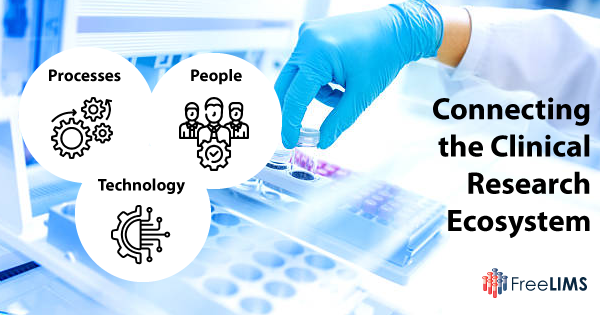In the world of clinical trials, success is determined by the smooth orchestration of a multitude of complex components. From recruiting the right participants to ensuring compliance with regulatory requirements, every step of the process must be executed with precision and care. That’s why access to the right tools, technologies, and expertise is absolutely critical. By consolidating knowledge, technology, and supporting services under one umbrella, the need for research sites to scramble and search for critical resources on an ad hoc basis can be eliminated. Instead, a comprehensive suite of interconnected tools and services can empower research sites to efficiently conduct trials with confidence. Addressing key challenges such as compliance, safety, and ethics can help bring important new treatments and drugs to market.
Just as a sturdy table requires equally strong legs to stand firm, any successful establishment or organization relies on three key pillars: processes, people, and technology (PPT). In this blog, we look at the components of the connected clinical research ecosystem through the lens of the PPT framework, which emphasizes the importance of considering all three aspects when building a successful organization.
Processes: Evaluation and Review Services by Institutional Review Boards (IRBs) or Institutional Biosafety Committees (IBCs)
The primary goal of creating the IRB and IBC is to protect the rights of participants and minimize the risks associated with genetically engineered treatments and vaccines for the safety of study staff, participants, and the community, respectively. Finding an unbiased reviewer is essential, especially for research funded by the industry. In the case of studies conducted at multiple sites, independent IRBs and IBCs offer quicker review processes that are attractive to industry sponsors.
How do you identify the appropriate match for your laboratory?
Search for an autonomous IRB (and IBC if needed) that has processes in place to ensure prompt and effective delivery of quality documentation, while also providing committed, attentive service and expertise to assist your research. To evaluate the review services of an IRB or IBC, consider verifying the use of electronic tools and trained staff, examining the committee roster to ensure necessary expertise, requesting a demonstration/training and checking for an API connection, and checking for relevant accreditations and audits from regulatory authorities. Check if the IRB has been audited by the Food and Drug Administration (FDA), Office for Human Research Protections (OHRP), or other regulatory authority in the past. Additionally, confirm that the IRB is registered with OHRP and the FDA. Full accreditation with the Association for the Accreditation of Human Research Protection Programs (AAHRPP) and a long-standing history of compliance is also an indication of reliability.
People: Professional Services
Technology-enabled professional services can help your organization simplify the study activation process, utilize technology investments to the fullest, reduce administrative workload, and achieve significant improvements in efficiency. For instance, negotiating budgets is a task that can take up a lot of time during the startup phase. However, professional services organizations can expedite this process, ease the burden of budget negotiations, and help achieve funding objectives. You could also hire research experts to take on temporary or permanent positions on-site or remotely to maintain the continuity of your clinical operations in case of staff turnover or unexpected project demands. Lastly, collaborating with a consultancy group offers a thorough, forward-looking method for navigating the research and development environment, ensuring adherence to regulations, and reducing risk across your clinical studies.
Technology: Clinical Trial Management System (CTMS), eClinical Solutions, and Laboratory Software for Clinical Research
Clinical research technologies can improve trial performance by enabling clinical sites to simplify workflows at every stage of the study, leading to time savings, reduced effort, and lower costs. It is crucial to ensure that a clinical research technology and service provider offers a complete range of technologies to optimize study processes.
A CTMS platform is a versatile tool that enhances various aspects of clinical trials such as study startup, participant management, finance, compliance, oversight, and reporting. It is scalable to any organization’s size and complexity and allows oversight across multiple departments, sites, and networks. A site-centric CTMS also includes remote workflow-enabling options that simplify recruiting, visits, and stipend payments. A comprehensive and effective CTMS can support an organization’s needs across multiple trials.
eClinical solutions are technologies that focus on participants and are intended to simplify source data collection, enhance regulatory management, and improve the consent process. These digital systems can make an organization more effective, compliant, and connected.
Finally, a discussion about technology in clinical research is incomplete without the mention of laboratory software for clinical research, also known as a Laboratory Information Management System (LIMS). Laboratory software for clinical research can help clinical researchers streamline their processes, improve data quality, manage participants’ consent, and increase productivity. By providing a centralized platform for data management and collaboration, laboratory software for clinical research can help accelerate the pace of clinical research and improve the quality of results. What’s more, competent LIMS vendors enable quick and secure sharing of data through integration between laboratory software for clinical research and other systems in the ecosystem.
Conclusion
Successful clinical trials rely on a combination of people, processes, and technology. Processes such as the evaluation and review services by Institutional Review Boards (IRBs) or Institutional Biosafety Committees (IBCs) help protect the rights of participants and minimize risks associated with clinical studies. Professional services can help organizations simplify study activation processes, utilize technology investments, and achieve significant improvements in efficiency. Clinical research technologies such as a CTMS platform and eClinical solutions can improve trial performance and simplify workflows. A clinical LIMS can help clinical researchers streamline their processes, improve data quality, and increase productivity. By consolidating these tools, technologies, and expertise, research sites can efficiently conduct clinical trials with confidence and bring important new treatments to market. Combining the right technologies and services can lead to faster and higher quality results, as well as increased revenue.


